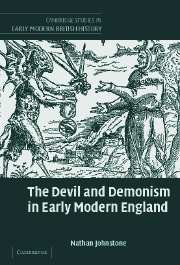Book contents
- Frontmatter
- Contents
- Acknowledgements
- 1 Introduction
- 2 The synagogue of Satan: anti-Catholicism, false doctrine and the construction of contrariety
- 3 Temptation: the Protestant dynamic of diabolic agency and the resurgence of clerical mediation
- 4 Satan and the godly in early modern England
- 5 Incarnate devils: crime narratives, demonisation and audience empathy
- 6 ‘What concord hath Christ with Belial?’: de facto satanism and the temptation of the body politic, 1570–1640
- 7 ‘Grand Pluto's Progress through Great Britaine’: the Civil War and the zenith of satanic politics
- 8 ‘The Devil's Alpha and Omega’: temptation at the cutting edge of faith in the Civil War and the Interregnum
- Conclusion
- Bibliography
- Index
- Cambridge Studies in Early Modern British History
2 - The synagogue of Satan: anti-Catholicism, false doctrine and the construction of contrariety
Published online by Cambridge University Press: 23 June 2009
- Frontmatter
- Contents
- Acknowledgements
- 1 Introduction
- 2 The synagogue of Satan: anti-Catholicism, false doctrine and the construction of contrariety
- 3 Temptation: the Protestant dynamic of diabolic agency and the resurgence of clerical mediation
- 4 Satan and the godly in early modern England
- 5 Incarnate devils: crime narratives, demonisation and audience empathy
- 6 ‘What concord hath Christ with Belial?’: de facto satanism and the temptation of the body politic, 1570–1640
- 7 ‘Grand Pluto's Progress through Great Britaine’: the Civil War and the zenith of satanic politics
- 8 ‘The Devil's Alpha and Omega’: temptation at the cutting edge of faith in the Civil War and the Interregnum
- Conclusion
- Bibliography
- Index
- Cambridge Studies in Early Modern British History
Summary
The study of the Devil in early modern English culture begins with the Reformation, or, more precisely, with the understanding of satanism that emerged out of Protestant attempts to comprehend the corruption of traditional Catholicism. As the will to reform in England gathered pace, Protestant polemicists targeted not only specific clerical abuses but the Roman faith as a whole. They adopted a long-established heretical association of the Pope with Antichrist, and behind Antichrist lay the Devil, the guiding hand of apocalyptic subversion. In describing how Satan came to exact such a profound influence over generations of ostensibly pious men and women, Protestants articulated a demonic agency which placed the Devil's power firmly in the human consciousness and in the manipulation of man's instincts, both godly and ungodly. In effect Catholicism might be a parody, a contradiction of everything sacred to the true faith. But this was hidden behind a pious gloss which had hoodwinked millions into their own eternal destruction. Nor were its victims naive or ignorant; many learned and zealous Christians continued to believe in the veracity of the Roman church. It fell then to the reformers to explain why Catholicism was such a convincing fake, and in so doing reveal its contrariety with Christianity. Paradoxically, this very process forced Protestants to engage with the spiritual and emotional experience which bound men to Catholicism, and to find a congruous place for the Devil within it.
- Type
- Chapter
- Information
- The Devil and Demonism in Early Modern England , pp. 27 - 59Publisher: Cambridge University PressPrint publication year: 2006
- 3
- Cited by



